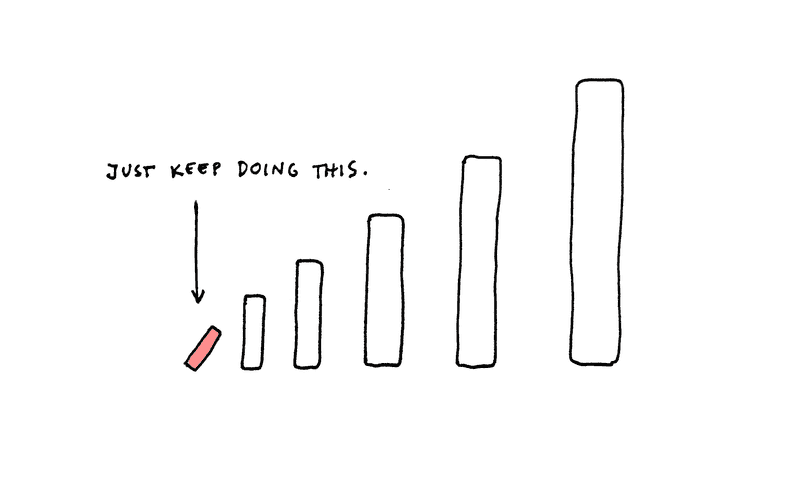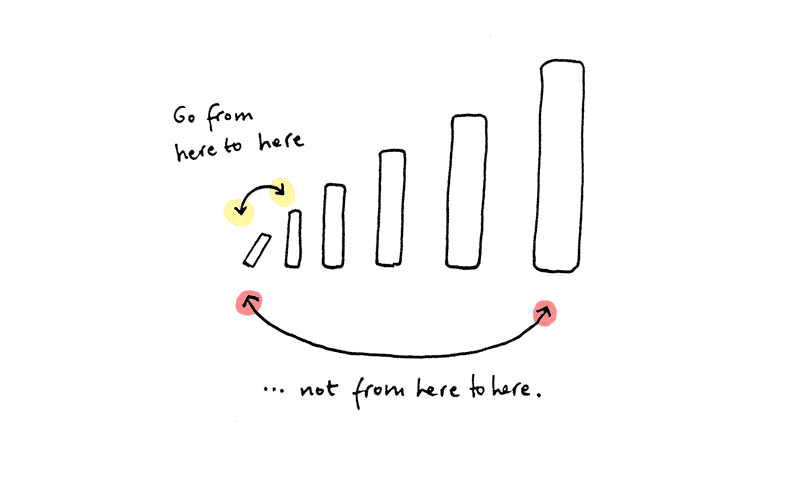Have You Quit Your 2021 Resolutions Already?

Here’s how I’m keeping mine, one step at a time.
This is the time of year when the excitement about New Year’s resolutions usually starts to fade away.
I recently wrote about why this year I am focusing on creating practices instead of setting goals: to avoid the pitfalls that make so many people quit.
One of my practices, the one I am focusing on for the first three months of the year, is to engage in daily activities that connect me to my body and to the present moment for a couple of hours.
I started really small: my first steps were to take ten conscious breaths and one sun salutation upon waking up every day. Since then, these have expanded into 45 minutes of meditation, a 15-minute strength and flexibility routine (often followed by a 20 minute run), daily dancing breaks, as well as regular walks and yoga sessions.
Not only have I not quit, but I am making progress every day and well on my way to establish a solid habit of being more present in my body.
In this article, I will explain the main principles and methods I am using to stay consistent.
What Comes After a Tiny Habit?
I was always skeptical about BJ Fogg’s Tiny Habits methodology. That is, until I tried it.
Tiny Habits is the most effective method I have ever found to get started on a new habit and maintain it. I now apply the principle of starting super small every time I want to build a new habit or help my coaching clients build one.
However, I have always struggled with knowing when and how to scale up from there. What comes after the first tiny steps — the ten conscious breaths, the one sun salutation, the writing of one sentence? How to increase intensity without losing motivation?
This: Minimum Viable Habits (MVH)

As I worked on my body/movement practice, the answers to those questions started coming in gradually and organically.
After consistently doing my tiny habit of one sun salutation every day, I decided to add a one-minute plank. I’d been wanting to strengthen my core for a while, and this seemed like a nice and easy way to start working on that. Easy peasy.
A few days later I noticed my body wanting some shoulder stretching after planking, so I added that. It felt natural (and it felt so good!). Eventually I found an article with a short powerful five-minute exercise routine, and I started adding those one at a time. Some felt right, some didn’t, so I kept what I wanted and left the rest out.
Eventually, my one sun salutation turned into a nice, sweet, intuitive ten minute movement routine that I do almost every day, and that became my new normal.
I now call this routine my Minimum Viable Habit (MVH): It’s the minimum I have to do every day in order to feel like I not only showed up, but also did something significant that made me feel accomplished in regards to my practice.
Notice that I said I do this routine almost every day: that is key. The tiny habit is still the minimum mandatory. But it’s exactly because I don’t force myself to do more that I end up doing the whole MVH roughly ninety percent of days: because it makes me feel like I am overachieving, which is super rewarding.
The same happened with my ten breaths tiny habit.
I slowly grew it into one minute of meditation, then two minutes, then five, then ten. Now ten minutes is my MVH. But here I went even further: I now usually do 30-45 min every day, and only around 15% of days I go back to ten minutes. I only went back to the tiny habit (10 breaths) once.
Why This Works
The main reason why this approach works so well is the fact that it doesn’t require any willpower or forcefulness.
The MVH makes everything easier because it gives me a clear next milestone to aim for after the tiny habit, and at the same time removes the pressure by making it optional. In other words, the resistance is removed because I have a clear path to follow, but I also have the freedom to not do it if I don’t want to.
I didn’t stop at the MVH, though.
Every time I engage in my practices I pay attention to what my body is asking for, and I add new things accordingly. Push-ups. Breathwork. Another stretch. The key is not to think that I “have to” add more, but to just do it intuitively and playfully.
I noticed that the less pressure I put on myself to “do more”, the more I actually do. And the more I do, the more I feel like expanding my practice even further. It’s becoming easier and easier to read my body’s cues: when it feels like vigorous movement; when it feels like resting; when it feels like being caressed or touching another body; when it needs more water or more air or more warmth or more love.
There is no end goal to achieve: there is just the pleasure of exploration and diving deeper into the experience of being in my body, one small step at a time, whenever and however I feel like it.
What I Am Working On Right Now
I love the habits I have right now, but I am feeling a calling for more movement in my days (anyone else spending a lot of time in front of the computer?) So I’m playing around with adding more movement to my days in a way that’s intuitive, playful, and sustainable.
This last week, I added another TH to my routine: after breakfast, I plan a slot later in my morning (in a break from work) to dance to a single song, and I choose the song straight away. This usually leads me to take the break when the time comes, and I get another five to six minutes of conscious body movement in my day.
My strategy right now is to cue myself with tiny habits all over my day, like planting the seeds of the behaviors I want to cultivate, and then growing from there.
This is my plan to move forward. I want to make embodiment and movement practices a natural part of my daily routine. So I’m observing the things I love to do already — running, walking, yoga — and asking myself:
“How could I make this into a Tiny Habit, and then a Minimum Viable Habit, so that I can make it happen consistently?”
And then I keep on experimenting until it becomes integrated in my routine, small step by small step.
The Biggest Lesson I’ve Learned With All This
Building habits is not about willpower.
The less pressure I apply, the more I feel like engaging in the practices I chose.
The only discipline required is to show up and to the tiniest step required, and then the rest is optional. The next steps are merely guidelines, but knowing what comes next helps remove resistance.
I am discovering more and more that building habits is about being gentle with myself and enjoying the process. My MVHs are usually created over several weeks of experimenting and doing what feels naturally good for me, so they are intuitive and easy to stick with.
I think a lot of people believe that discipline is about forcing ourselves and never falling below a certain standard, but I think it’s much more about setting clear intentions and then finding the path of least resistance towards fulfilling them.